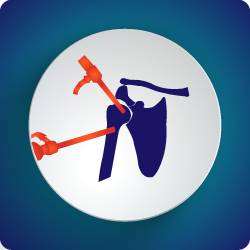
Shoulder Arthroscopy
Dr Chien-Wen Liew – Adelaide, South Australia
Shoulder arthroscopy is a minimally invasive technique used to view the inside of the shoulder joint. During arthroscopy, two main compartments can be visualised. This is the glenohumeral joint (i.e. the main ball and socket part of the shoulder joint) as well as the subacromial space (under the acromion and clavicle region). Many pathologies that are injured in the shoulder are amenable to shoulder arthroscopy. Shoulder arthroscopy is similar to knee arthroscopy in that it uses very similar instruments to look inside the joint and fix any issues. Shoulder arthroscopy can visualised, assess and fix the following types of injuries:
- SLAP tears
- Rotator Cuff tears
- Labral injuries
- Instability of the shoulder
- Cartilage damage to the shoulder
- Bursitis
- Removal of loose bodies
- Acromioclavicular Joint arthritis
- Infection
A general anaesthetic is used for all cases of shoulder arthroscopy and in general a special nerve block is used to remove pain from the shoulder. The nerve block is placed under ultrasound guidance most of the time, ensuring accurate placement of the local anaesthetic into the area. Once the area has been cleaned thoroughly (especially in the axilla), the portals are made. Several small 1cm incisions are made around the shoulder to allow visualisation with the small camera, and to pass instruments around the shoulder to fix any injuries. Fluid is pumped through the shoulder to inflate the area which is normally relatively tight. This allows safe passage of instruments around the shoulder.
During surgery, both main compartments are seen, and any work is done depending on the history given and the areas of concern. There are some shoulder conditions that are best treated straight away rather than waiting. This includes instability surgery in young patients, as the chances of further instability is increased in those who do not undergo operations. Sometimes physiotherapy is suitable and an operation is not needed. This is all very dependent on the type of injury sustained.
Once your shoulder has undergone a shoulder arthroscopy you will spend several hours in the recovery unit before being transferred to the ward. A special waterproof dressing is applied to your shoulder during surgery, but must not get wet for the first 2 weeks. Although it is waterproof, it can still let micro particles of water and dirt in if it is soaked wet. Dr Chien-Wen Liew is very meticulous about his post operative regimen and advises that all patients be kept at home, in a safe environment until the wounds are sealed.
Your arm is generally placed in a sling, and after the operation, the immediate physiotherapy is highly dependent on what internal structures were repaired during the surgery. In some cases, you are allowed to move your arm as you can tolerate. In others, you will need to avoid certain exercises for approximately 6 weeks. This will be made very clear to you prior to you leaving hospital. Most patients only stay in overnight for shoulder arthroscopic surgery.
Pain relief is via tablets after the operation, and you will be given a set of tablets with a special regimen to keep your pain under control. Your first scheduled appointment after surgery is usually at 2 weeks to check your wounds and reiterate your physiotherapy plan.
For more information on shoulder arthroscopy, please contact the office of Dr Chien-Wen Liew on (08) 7099 0188 to make an appointment.
Thankyou for visiting this website. Please note that the information held within this site and on this page are for educational purposes only. Please consult your doctor or health professional always prior to considering any medical therapy or intervention. If you notice an error on this site, please use our contact form to let us know so we can rectify any issues. All information and graphics on this site are the property of Sempire Designs.
